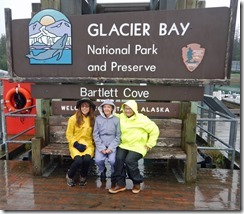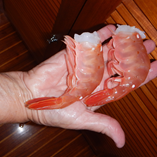The map below shows where we stayed overnight on our 2015 cruise. If you click on a place mark additional information (i.e., place name, distance, engine hours, anchor chain)will pop up.
Tuesday, August 18, 2015
2015 – By the Numbers
It turns out that 2015 was our shortest cruise yet of the five total cruises we’ve done to Alaska since we off loaded Alpenglow in January 2010. Ignoring our “shakedown” cruise, we left on May 6 and returned on August 17, a trip length of 104 days. The table below summarizes the easily tabulated values from the ship’s log.
| Departure date | May 6 |
| Return date | August 17 |
| Duration | 104 days |
| Distance traveled | 3580.1 nautical miles |
| Total engine hours | 629.2 |
| Total genset hours | 28.7 |
| Number nights at anchor | 67 |
| Number nights at mooring buoy or float | 7 |
| Number nights at dock | 29 |
With regards to average speed, I usually subtract the number of hours spent idling while fishing or sightseeing (i.e., time not underway), 42.4 hours in 2015, from the total engine hours and divide that value into the total distance traveled. Using that method, we averaged 6.1 nm/hour.
Monday, August 17, 2015
Back in Puget Sound
We arrived today at our yacht club’s Bainbridge Island, Eagle Harbor outstation concluding our summer cruise for 2015. We shortened our season on account of my (Kurt) developing a hernia during the cruise and our having the desire to get it resolved expediently before we head south to Tucson for the winter.
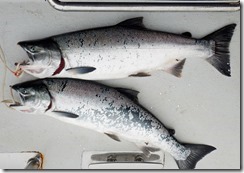 While we traveled through British Columbia pretty fast after finally leaving Ketchikan, Marcia did make the best of it by catching 8 silver salmon over five days of fishing. Three of the salmon were caught in two areas Marcia hadn’t fished before which was nice addition to her knowledge base. We also were successful prawning in two areas we hadn’t tried before.
While we traveled through British Columbia pretty fast after finally leaving Ketchikan, Marcia did make the best of it by catching 8 silver salmon over five days of fishing. Three of the salmon were caught in two areas Marcia hadn’t fished before which was nice addition to her knowledge base. We also were successful prawning in two areas we hadn’t tried before.
We dawdled an extra day north of Cape Caution waiting for the nice conditions during the open section exposed to ocean swell. Our patience rewarded us with calm conditions and a surprisingly quick transit (for us, anyway) from Fury Cove to Port McNeill. We covered the 66 miles in 10 hours from engine on at anchor to engine off at the dock.
Each year, as we head south we experience the “culture shock” of the crowds in the popular cruising areas. When we entered Squirrel Cove on Cortes Island, we knew we’d have company but we weren’t expecting the 70+ boats we found there. We squeezed in for the evening, then joined the line of boats heading south from there the next morning.
We’re not sure of our immediate plans but it is unlikely we’ll do any more extended cruising this year. Perhaps some short trips in Puget Sound should the nice weather be too compelling to stay on the dock. We are already looking forward to 2016, though, and returning to Alaska.
Friday, July 31, 2015
Being Flexible
So we’ve postpone our departure from Ketchikan another day on account of the “snotty” weather. We were all prepared to leave despite the rain and wind because the forecast was for improving conditions as the day progressed.
All of the electronics, including the VHF radio were operating, when we heard two recreational boaters conversing on the radio. One was just leaving Ketchikan (they were transmitting their position via AIS) and the other was about 6 or 7 miles from Ketchikan on the way to Prince Rupert as we were intending. The vessel further out said they were turning around on account of sea conditions (“The dog was howling”). The closer vessel said they were pushing on based on the forecast. The further out vessel shortly thereafter called back to say they were pulling into a temporary anchorage in order to wait for conditions to improve. Both boats had Foggy Bay as their destination for the night (same as us).
We already knew that a “Mother Goose” flotilla of six boats from NW Explorations had left yesterday for Foggy Bay with the goal of Prince Rupert today. If conditions were poor just a few miles from Ketchikan, we thought that there was a high likelihood that they’d take a weather day rather than pound their way across Dixon Entrance.
We knew that on account of our speed, we’d likely be one of the last boats to arrive to a very crowded Foggy Bay. We’d also be one of the last to arrive the next day to a very crowded Prince Rupert Rowing and Yacht Club marine (just about the only marina for transients in Prince Rupert). Since the weather for Saturday, August 1 is forecast to be better yet, we’re being flexible and spending another day in Ketchikan to let this wave of boaters heading south to get ahead of us. Of course there is another “wave” all ready building around us by that is just the way things are.
In the mean time, I am taking this opportunity and Internet connectivity to post a video of Dall’s Porpoises surfing our bow wake.
And another video of us crossing the entrance of Behm Canal as it meets Clarence Strait just north of Ketchikan. The wind was blowing SE 15-20 knots and the seas were 3 to 4 feet with a short period. We were meeting the waves on the starboard forward quarter so we weren't rolling much, just the bow crashing a bit.
Thursday, July 30, 2015
Ketchikan - The Rain Continues
Now I don’t want to sound like a broken record or a “weather brat” but this rain is starting to get to me. For additional “amusement”, we’re now getting a touch of wind added to the precipitation.
 It hasn’t been all bad, though. We did harvest prawns in Hoonah Sound and Pybus Bay, and we broke our fishing dry spell by catching 3 halibut in Fredrick Sound.
It hasn’t been all bad, though. We did harvest prawns in Hoonah Sound and Pybus Bay, and we broke our fishing dry spell by catching 3 halibut in Fredrick Sound.
We also had some of the best whale activity of the season in and around Pybus Bay. The whales were feeding in the same area where we placed our pawn traps which caused us 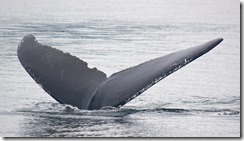 concern that the traps might be inadvertently dragged away by a humpback whale chowing down on a herring ball near our float and line. Fortunately, the whales avoided our lines while they did their fishing.
concern that the traps might be inadvertently dragged away by a humpback whale chowing down on a herring ball near our float and line. Fortunately, the whales avoided our lines while they did their fishing.
While we had wind and rain, we avoided the major thrubbing we had in Clarence Strait that we experienced last year. Rather than 30 knot winds and 6 foot seas which we mostly avoided by holing up in Meyers Chuck last year, we only had 15 knot winds and 3 foot seas. Of course these were Clarence “3-footers” which means they were closely spaced and steep, making for a bouncy, wet ride.
We plan on leaving Ketchikan tomorrow, July 31, having spent an extra day here waiting for forecasted calmer conditions crossing Dixon Entrance into Canada. We’re hoping the overall weather begins to improve as well.
 While I whine about the weather, the cats only whine/meow about food or its absence. The rest of the time they sleep.
While I whine about the weather, the cats only whine/meow about food or its absence. The rest of the time they sleep.
-------------
P.S. – Our sistership, Laysan, that crossed the Pacific to its homeport in Honolulu in 2011-12, is now relocating to the Pacific NW. Its journey can be followed at https://roundtopdr.wordpress.com/
Wednesday, July 22, 2015
A Rainy Visit
While in Juneau we picked up Marcia’s cousins Chris, Diane and Diane’s husband, Ron, for a 2-week cruise from Juneau to Sitka with a visit to Glacier Bay National Park. Chris and Diane have lived in Arizona for over 40 years so we warned them that Alaska weather would be radically different. It turned out the weather was a bit more “Alaskan” than even we expected.
Below is a table showing the Juneau Airport weather summary for the first 3 weeks of July. Our guests flew in the evening of July 7 and departed today, July 22. The highlighted dates coincide with their full days visiting.
| Date | Max Temp | Min Temp | Avg Temp | Precip |
| July 1 | 64 | 46 | 55 | 0.42 |
| July 2 | 57 | 52 | 55 | 0.20 |
| July 3 | 58 | 48 | 53 | 0.09 |
| July 4 | 74 | 44 | 59 | 0.00 |
| July 5 | 76 | 48 | 62 | 0.00 |
| July 6 | 84 | 53 | 69 | 0.00 |
| July 7 | 76 | 55 | 66 | T |
| July 8 | 63 | 55 | 59 | 0.64 |
| July 9 | 66 | 55 | 61 | 0.01 |
| July 10 | 61 | 54 | 58 | 0.34 |
| July 11 | 62 | 54 | 58 | 0.40 |
| July 12 | 63 | 56 | 60 | 0.92 |
| July 13 | 58 | 54 | 56 | 1.26 |
| July 14 | 60 | 52 | 56 | 0.66 |
| July 15 | 59 | 52 | 56 | 0.38 |
| July 16 | 59 | 52 | 56 | 0.04 |
| July 17 | 59 | 53 | 56 | 0.26 |
| July 18 | 67 | 54 | 61 | 0.08 |
| July 19 | 59 | 51 | 55 | 0.63 |
| July 20 | 66 | 50 | 58 | 0.04 |
| July 21 | 76 | 46 | 61 | 0.00 |
While our local weather as we cruised certainly varied from that of Juneau, this isn’t a bad representation of what we saw along the way. Fortunately, they heeded Marcia’s warnings and brought their rain gear.
We ended up cutting short our visit in Glacier Bay by two days (using 5 days of our 7 day permit) because Marcia & I felt we had hit the highlights given the weather we were experiencing.
The left photo is Chris, Diane & Marcia at the Bartlett Cove NPS dock. The right photo is Chris, Diane and Ron at the end of Tarr Inlet with the Margerie Glacier in background.
Fortunately, wildlife viewing isn’t adversely impacted by rainy weather. The birds around South Marble Island were abundant and we had a wonderful “whale dance” outside of North Sandy Cove.
 From Bartlett Cove we headed to Sitka via Chatham Strait and Peril Strait. Along the way we stopped at some of our favorite anchorages. We shared anchorages with other boats, adding to our impression that this has been a busy cruise season in Alaska. In Douglass Bay in Hoonah Sound, the other boat there was David Cohn’s Diesel Duck Shearwater which he brought across the Pacific on its own bottom from China in 2013.
From Bartlett Cove we headed to Sitka via Chatham Strait and Peril Strait. Along the way we stopped at some of our favorite anchorages. We shared anchorages with other boats, adding to our impression that this has been a busy cruise season in Alaska. In Douglass Bay in Hoonah Sound, the other boat there was David Cohn’s Diesel Duck Shearwater which he brought across the Pacific on its own bottom from China in 2013.
 The weather began to clear a bit as we headed into Sitka from our last anchorage. Low clouds hovering above the hills outside Sitka provided a dramatic back drop as we headed into to conclude Chris, Diane and Ron’s cruise with us.
The weather began to clear a bit as we headed into Sitka from our last anchorage. Low clouds hovering above the hills outside Sitka provided a dramatic back drop as we headed into to conclude Chris, Diane and Ron’s cruise with us.
From here, we’re starting our trip south to Puget Sound. For a number of reasons, we’ve decided to wrap things up early and hope to be back around the third week of August.
Wednesday, July 8, 2015
Feeding the Fish
So we left Petersburg with high hopes for equaling last years fishing results in Fredrick Sound. As we entered Pybus Bay on the way to Cannery Cove, we dropped three prawn pots in the same location as we did last year that gave us good results.
After a quiet night at anchor being the sole boat, we headed out to the fishing grounds on the west side of the West Brother Island. First we stopped to reap a disappointing prawn harvest. Probably it was the hubris of taking the area for granted and putting three pots down instead of our normal two. We reset two pots in a different area using the tried and true method of looking where somebody else, hopefully better informed than us, placed theirs.
When we arrived on the fishing grounds, Marcia began her utmost to repeat her 2014 performance. As Marcia joked, she must have caught the two stupid halibuts last year because the wily fish underneath our boat repeatedly stole the herring and octopus off of her barbed circle hooks. The worst offense occurred when one fish (or perhaps a “gang”) took all three chunks of herring from each hook of a treble hook.
Eventually we called it quits and headed back to Cannery Cove for the night. Perhaps it was the forecast for wind and rain that prompted boats to head for the protection of Cannery Cove, but in any event, there were four other boats in the anchorage that night.
The next morning, after a rainy and blustery night, we headed out and pulled our two prawn pots from the previous day. We had been sufficiently humbled by the prawn gods so they rewarded us with a nice haul, sufficient for a couple of meals. The halibut gods, though were not appeased and the fish remained elusive. The night was spent in the nook between West Brother Island and the small islets on its west shore. A very scenic anchorage but not one we’d want to weather a storm in.
From there we continued up to Gambier Bay and some more disappointing fishing, both for halibut and prawns. We tried a new (to us) anchorage behind Good Island. It too was scenic but not one we’d want to be in during any significant weather.
The next day we crossed Stephens Passage headed for Port Houghton and Sanborn Inlet. We dropped a couple of prawn pots near the entrance just in case our luck had changed. The next morning upon departure for Tracy Arm Cove we were pleasantly surprised to find dinner waiting for us in the pots.
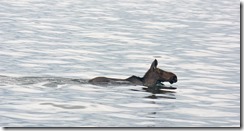 As we approached our destination, Marcia saw what she first thought was a log or dirty piece of ice floating in the water. As we got closer, we saw it was a moose swimming in Holkham Bay. We were quite far from shore and its origination or destination weren’t totally clear. Currents are pretty swift there so it could have easily been taken well off its intended course.
As we approached our destination, Marcia saw what she first thought was a log or dirty piece of ice floating in the water. As we got closer, we saw it was a moose swimming in Holkham Bay. We were quite far from shore and its origination or destination weren’t totally clear. Currents are pretty swift there so it could have easily been taken well off its intended course.
From Tracy Arm Cove, you can visit either Tracy Arm and the Sawyer Glaciers or Endicott Arm and the Dawes Glacier. We’ve been up Tracy Arm twice but had never been up 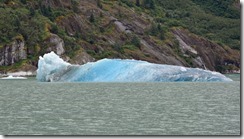 Endicott Arm. We decided to try the new (to us) area and headed out the next morning.
Endicott Arm. We decided to try the new (to us) area and headed out the next morning.
As we started down Endicott Arm, the ice chunks in the water were large but infrequent enough they were easy to dodge. As we got further in, smaller chunks of ice were common and often difficult to see in the filtered light from the cloudy sky. At the head of Endicott Arm was the Dawes Glacier, the source of the ice in the water.
Our original plan was to do Tracy Arm the day after Endicott Arm but a weather forecast for 30 knot winds persuaded us to head for the public dock in Taku Harbor and wait out the blow. Other boaters had similar ideas and the dock was pretty full when the winds started to pick up.
From Taku Harbor we made our way to Juneau and its Statter Harbor Marina in Auke Bay, where we were fortunate to find a spot without a lot of searching. From here we’ll pick up Marcia’s Arizona cousins whom we’ll take first to Glacier Bay National Park and then to Sitka where they will depart on July 22.
Tuesday, June 23, 2015
The Long Way Around
Marcia and I often joke about a Labor Day weekend trip more than 20 years ago in which we traveled 550 miles from our Seattle home to Leavenworth (typically a 120 mile drive) via Canada. As explanation, I’ll say our original goal was Hozomeen, a North Cascades peak just south of the border whose shortest access is via Canada. Relentless rain washed that goal away and kept pushing us east searching for blue sky and ultimately to Leavenworth.
Something like that has happened in the 2-1/2 weeks since we left Wrangell on June 5. We are now in Petersburg, about 45 miles from miles from Wrangell via Wrangell Narrows. The route we took was a “little” less direct and totaled about 626 miles. Along the way we took a detour to within 20 miles of Craig on Prince of Wales Island, headed out to Sitka on 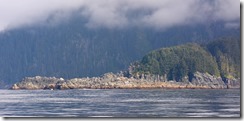 the West coast of Baranof Island via Peril Strait, continued south along the coast of Baranof, rounded Cape Ommaney, recrossed our earlier path (thus completing a circumnavigation of Baranof Island), overshoot Petersburg by going to the north end of Dry Strait (we were able to pick up VHF calls to the Wrangell harbor master), then finally docked at Petersburg on June 21. Thank heavens it’s the journey not just the destination that matters.
the West coast of Baranof Island via Peril Strait, continued south along the coast of Baranof, rounded Cape Ommaney, recrossed our earlier path (thus completing a circumnavigation of Baranof Island), overshoot Petersburg by going to the north end of Dry Strait (we were able to pick up VHF calls to the Wrangell harbor master), then finally docked at Petersburg on June 21. Thank heavens it’s the journey not just the destination that matters.
 The highlights since leaving Sitka include two lovely new (to us) anchorages on the West coast of Baranof Island, Kristoi Basin and Puffin Bay, and a tremendous humpback whale experience outside of Tebenkof Bay. We turned off the engine and watched a pod of 15 to 20 whales feeding (including bubble feeding) over a broad area. To hear them breath from hundreds of yards away is always a moving experience.
The highlights since leaving Sitka include two lovely new (to us) anchorages on the West coast of Baranof Island, Kristoi Basin and Puffin Bay, and a tremendous humpback whale experience outside of Tebenkof Bay. We turned off the engine and watched a pod of 15 to 20 whales feeding (including bubble feeding) over a broad area. To hear them breath from hundreds of yards away is always a moving experience.
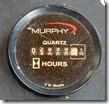 Our boat passed a milestone as well, accumulating 3000 hours on the main engine on the leg into Petersburg. That accumulation is in the 5-1/2 years since we off loaded the boat in Seattle in January 2010.
Our boat passed a milestone as well, accumulating 3000 hours on the main engine on the leg into Petersburg. That accumulation is in the 5-1/2 years since we off loaded the boat in Seattle in January 2010.
From here, we have about a 130 mile journey to Auke Bay, in Juneau. We’ll take it leisurely over 10 or 11 days but the route will probably be more direct than this most recent path.
Saturday, June 13, 2015
In Sitka
We’re currently in Sitka after having stopped in Wrangell, made a feint towards Craig then shifting our destination to Sitka.
In Wrangell, we had a great visit with our friends, Dorothy & Dave Nagle, owners of the Seahorse Marine Diesel Duck DavidEllis. They’ve been in a boatyard in Wrangell since last fall recoating their boat. I use the term “coat” because “paint” does not do justice to the multiple layers of protectants than go into keeping the corrosive effects of sea water, oxygen and sun from turning a boat (especially a steel boat) into a piece of scrap. Journalist Jonathan Waldman released a book this year, Rust, describing the ongoing struggle of humankind to protect its constructs against corrosion.
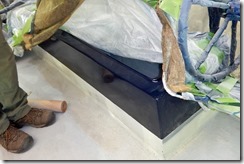 Dorothy and Dave hope to be back in the water and ready to cruise shortly after the July 4th holiday. We got a sneak preview of the glossy finish they’ll have when everything is complete. We’ll be jealous.
Dorothy and Dave hope to be back in the water and ready to cruise shortly after the July 4th holiday. We got a sneak preview of the glossy finish they’ll have when everything is complete. We’ll be jealous.
While in Wrangell, the blocking high that brought the sunny weather to SE Alaska in May decided to leave and we ended up staying an extra day while a bit of wind and rain passed through.
From Wrangell, we decide to head over to Craig on the west side of Prince of Wales (PoW) Island. Sea conditions were generally favorable so we made it a long day, heading across the top of PoW, down to Shakan Bay and hit Dry Pass in El Capitan Passage just about high tide. We anchored the night in Devilfish Bay about 6 miles south of the El Capitan caves.
The next day we headed to Salt Lake Bay, about 30 miles away. We had enjoyed our visit there in 2014 and wanted to visit again. By the time we reached Salt Lake Bay, the rain began to fall. We set our anchor in the rain and retrieved it in the rain next morning. In the mean time, we concluded that fishing would probably be better near Sitka so we retraced our path from the previous day to Devilfish Bay.
 The next morning we went back through Dry Pass in El Capitan Passage. It gets narrow in certain spots and we had to wait for the small cruise ship Wilderness Discoverer to pass through one section before proceeding.
The next morning we went back through Dry Pass in El Capitan Passage. It gets narrow in certain spots and we had to wait for the small cruise ship Wilderness Discoverer to pass through one section before proceeding.
Once back in Sumner Passage, we headed towards Keku Strait and the south entrance to Rocky Pass. We dropped the anchor and took an early dinner break waiting for high tide in the pass. At 5:30 pm we restarted the engine, pulled the anchor and covered the remaining 14 miles to our anchorage for night in Stedman Cove.
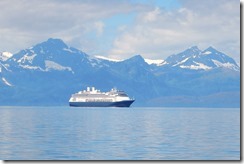 From Stedman Cove we went to the always scenic Red Bluff Bay on Baranof Island for the night. The day was quite stunning with calm winds and lots of sun. Along the way we passed the Holland America cruise ship Amsterdam. Chatham Channel being a bit wider than
From Stedman Cove we went to the always scenic Red Bluff Bay on Baranof Island for the night. The day was quite stunning with calm winds and lots of sun. Along the way we passed the Holland America cruise ship Amsterdam. Chatham Channel being a bit wider than  Dry Pass, we didn’t have to wait our turn, although I did alter our route to keep the passing more than 3/4 mile.
Dry Pass, we didn’t have to wait our turn, although I did alter our route to keep the passing more than 3/4 mile.
The weather turned decidedly cooler and wetter than next two days as we first went to Douglass Bay in Hoonah Sound than on to Sitka the next. High temperatures struggling to get above 50 degrees and frequent rain showers.
The current plan is to do some fishing in the Sitka area before returning to Sitka to start our way to Juneau.
Saturday, May 30, 2015
Sunny Alaska
A big old blocking high has been sitting off the coast for a couple of weeks keeping the BC coast and SE Alaska generally warmer and drier than normal. It was nice to not have to worry about big storms but the prevailing NW 15-25 winds can build up wave height.
We monitored conditions and the forecast for Dixon entrance, the section of water separating BC from Alaska, which is open to ocean swells looking for the best conditions. Monday and Tuesay, May 18-19, looked optimal. We left our anchorage at Kumealon Inlet on May 18 bound for Brundage Inlet on Dundas Island which borders Dixon Entrance. We were making good time as we had the current with us much of the way.
A few mile short of our turn in to Brundage Inlet, Marcia and I concluded that conditions in Dixon Entrance were good and probably better than they'd be the next morning so Marcia made a call to the US Customs and Border Protection office and obtained permission to use the Foggy Bay anchorage in Alaska before clearing customs. After a 12 hour day, we pulled into Foggy Bay where three other boats had done likewise.
With an "oh-dark thirty" start the next day, we arrived in Ketchikan in the late morning and began our chores and reprovisioning. While there, we visited with David Cohn on the MV Shearwater, a classic style Diesel Duck made by same builder, Seahorse Marine, as our boat.
To get us started with fishing, after Ketchikan we like to head out around (at least partways) Revillagigedo Island (the island on which Ketchikan is located) in Behm Canal. We have some favorite locations where we're usually able to do some crabbing and prawning.  First, though we stopped at the Alaska home of Pete and Brenda. This last year they purchased as a winter home across street from the Green Valley, Arizona winter home our friends the Crowders (they cruised with us in 2011 and 2013). Pete and Brenda live in a
First, though we stopped at the Alaska home of Pete and Brenda. This last year they purchased as a winter home across street from the Green Valley, Arizona winter home our friends the Crowders (they cruised with us in 2011 and 2013). Pete and Brenda live in a home they built on Deep Bay which is on the NW corner of Moser Bay. We anchored in Deep Bay, and dinghied to shore to visit with them and their neighbors.
home they built on Deep Bay which is on the NW corner of Moser Bay. We anchored in Deep Bay, and dinghied to shore to visit with them and their neighbors.
From there it was several days crabbing and prawning around Behm Canal as far as Walker Cove in Misty Fiord National Monument and then back to Klu Bay. After Klu Bay, we slogged up Clarence Strait, into Ernest Sound and up to Thoms Place.
Next, we'll head to Wrangell continuing to fish and checking out some new (to us, anyway) anchorages along the way.
Saturday, May 16, 2015
Our Lot in Life
That phrase also describes all of the routing we've done since we made the second start to our 2015 cruise after having to return to our winter homeport to deal with our misbehaving electronic compass (it is working fine so far, by the way). The delayed start meant we missed our optimum timing at Seymour Narrows, an early morning slack before the ebb. We like to ride the building ebb down Johnstone Straits. That ebb will add a couple of knots to our normal sedate cruising speed of 6-7 knots.
The week delay meant the slack before the ebb was closer to mid-day. Unfortunately, the relatively stable high pressure ridge off the coast was generating afternoon NW winds of 15-25 knots. When those winds hits the ebb current in Johnstone, the waves build up and you have short steep waves combined with current eddies, an uncomfortable combination.
We chose the more protected channels through, Yuculta, Gilliard, Dent, Green and Whirlpool rapids, as the winds are generally less there. Unfortunately, all of those rapids require timing. We split them over two days, the first 3 on one day and the other 2 on the second day. The travels on the second day, lasting 14 hours, got split into 3 sections with brief interludes between the sections. That was so we could time Whirlpool and then later, Chatham Channel which got us into the Broughtons. It was just our lot in life to have to travel the slower route this year.
Since getting past those hurdles, our pace has quickened. The starts are still early but at least we’re racking up the miles and hope to be in Ketchikan (weather permitting) in a few days.
Tuesday, May 5, 2015
Migrating North
We started the northward migration from our Arizona winter home the last full week of March. The cats, while not amused by the 1600 mile drive, are tolerating it better. Rather than individual carriers, we use a soft sided pet pen sold at the www.drfostersmith.com web site. That way they are together and have more room to stretch out. Additionally, we have a litter box available outside the pen for their use. At the smallest sign of agitation, Marcia will make it available to them which they both did at least once as we were driving along.
Upon arrival at our winter moorage in Eagle Harbor, we’ve been immersed in getting the boat ready for the summer cruise. We had a few equipment issues that needed resolving and we preemptively do other things because we’ve used the boat enough that things are wearing out.
We managed to take care of everything on the list and start our cruise on Sunday, April 26. The first stop was in Anacortes to fill fuel tanks for the season and have routine service performed on our furnace. A side benefit was meeting up with friends Natala and Don Goodman. They’ve both retired and now live in a newly remodeled home on Lake Samish. Their retirement indulgence is a Cessna 182 on which they are going to put floats. Should everything come together, they might fly up to B.C. and meet us somewhere. We’d love to see that happen!
The morning we were leaving Anacortes for the next leg of the trip north, we got an alarm on our autopilot saying that it was not receiving the compass heading data from our GPS compass shortly after we turned on the navigation electronics. We switched to our backup electronic compass and continued to monitor the status of the primary compass as we left Anacortes. After doing a lot of tests, we decided to head back to our winter moorage to figure out the problem.
We ended up taking the unit to the manufacturer, Comnav, in Vancouver. After testing and discussion with them, we concluded that the problem was precipitated by moisture build up in the unit. Also, the way it was wired into the navigation system was not optimal. We’ve now dried the unit out, took actions to mitigate future moisture issues and made the recommended wiring changes. The unit appears to be operating stably now.
At this point, we are targeting Wednesday, May 6 for the second start to our summer cruise. The migration northward continues.
Tuesday, March 17, 2015
Old Trips Remembered
One of the challenges I’ve taken on in retirement is organizing the thousands of photographs I’ve taken since the early 1970’s when I bought my first SLR camera. Pretty much everything since I bought my first dSLR in 2004 has been digital. Before that time, most everything were slides (“don’t take my Kodachrome away”) which require the extra step of digitizing. But just having a digital images isn’t enough, the hard work comes from adding metadata about the where, what and when of the image (I won’t even worry about the “why”)
I’ve made a pretty good dent in the numerous boxes and trays of slides but I keep getting distracted and slowed by looking at the slides and remembering the wonderful trips and beautiful places they capture (or at least try to capture). I’ve now concluded that the main function my photos now serve is simply to help me remember.
So in keeping with that purpose, I’ve created another blog, http://oldtripsremembered.blogspot.com/, in which I’ve written a brief description and pulled a couple dozen images of some of the trips I’ve experienced. Unlike most blogs which are a contemporaneous chronicle of events and thoughts, this new blog looks back and records my current memory of the trip (which is likely a bit ragged) and what I now feel about the trip (which is probably shaded to the “rose” end of the spectrum).
I as I write this, I am certainly not done, but I’ve made progress. I just hope this isn’t my personal “Nine Billion Names of God” and that once complete, I can continue with new trips and beautiful places.

